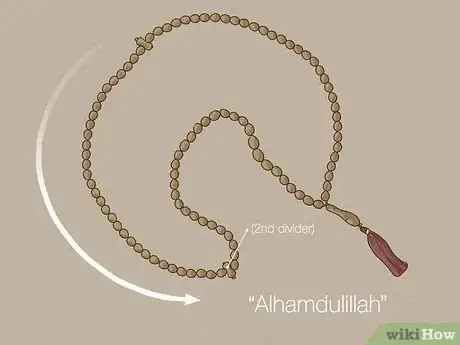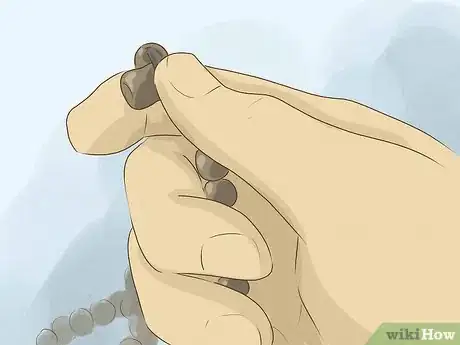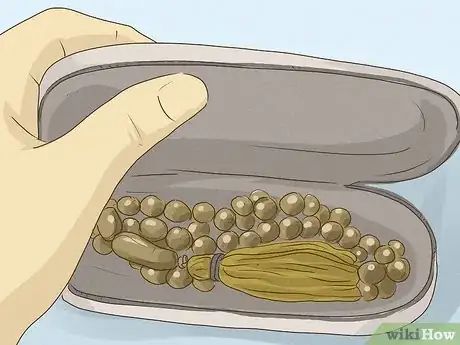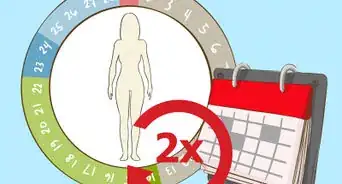This article was co-authored by wikiHow Staff. Our trained team of editors and researchers validate articles for accuracy and comprehensiveness. wikiHow's Content Management Team carefully monitors the work from our editorial staff to ensure that each article is backed by trusted research and meets our high quality standards.
This article has been viewed 222,460 times.
Learn more...
The misbaha is a bracelet made of 99 beads, each meant to represent the 99 names of Allah. People who follow Islam commonly use them during Dhikr and as a totem to ease worrying (hence the colloquial name “worry beads”). There are also 1 or 2 small beads dividing the chain of larger beads into 3 parts of 33 so you can keep track of how many times you’ve recited “Subhan Allah,” “Alhamdulillah,” and “Allhu Akbar.”
Steps
Performing Dhikr
-
1Hold the misbaha above the tail between your thumb and index finger. Place your thumb and index finger just above the tail (at the start of the ring of beads). Let the tail drape down near your palm. You can use whichever hand feels most comfortable for you.
- The tail is the extra string of beads that is separate from the circular bracelet of 99 beads.
-
2Repeat “Subhan Allah” 1 time per bead, 33 times. Repeat the phrase aloud or in your mind 1 time while grasping a single bead between your thumb and index finger. Then, move your fingers to the next bead and repeat it again. Continue this process 31 more times until you’ve grasped 33 beads total and repeated the phrase 33 times.[1]
- “Subhan Allah” means “glory be to Allah” and it’s meant to praise Allah for being above imperfection.
- Try to think of nothing but Allah as you recite this phrase.
Advertisement -
3Run your thumb and forefinger over the divider beads. The misbaha has divider beads to mark the 3 sections. The first divide made up of 1 or 2 beads comes after the first 33 regular beads. You don’t have to do anything special for the divider beads, it’s just a reminder to switch your focus to the next phrase.[2]
- If you like, use this bead as a grounding “pause” to take a deep breath and allow your mind to focus wholly on Allah.
-
4State “Alhamdulillah” 33 times while grasping 1 bead at a time. Hold the misbaha between your thumb and index finger and feed it through your fingers each time you repeat “Alhamdulillah” aloud or in your mind. Do this 33 times until your fingers meet the next divider bead.[3]
- “Alhamdulillah” means “all thanks and praises be to Allah” and it’s a common prayer to express gratitude. It’s also something Islamic people might say after sneezing.
-
5Shift your attention when you come to the divider beads again. Once your fingers touch the smaller beads dividing the last 33 and the next 33, get ready to recite the final part of Dhikr. You can pause over these beads to take a breath or go right into the next phrase.[4]
- Avoid getting distracted or stopping altogether when you encounter the divider beads—they’re not meant to act as a bookmark or end point.
-
6Recite “Allahu Akbar” 33 times while passing over the last 33 beads. As the final stage of Dhikr, say or think “Allahu Akbar” each time your thumb passes over a bead (for a total of 33 times). If you like, it’s acceptable to add an additional “Allahu Akbar” to close your prayer session.[5]
- “Allahu Akbar” means “Allah is most great” or “Allah is the greatest”—it’s a phrase that comes up most often in all forms of Islamic prayer.
Displaying a Misbaha
-
1Wrap it around your wrist as a reminder to focus on spirituality. Wrap the misbaha around your wrist so you can take it off and use it for daily Islamic prayers or other spiritual rituals throughout the day. If you’re new to Islam or any spiritual practice, seeing it on your wrist can also act as a reminder to praise Allah or get in touch with the present moment.[6]
- Keep in mind that the misbaha’s tail will hang down lower than the main strings of beads, so if you work with your hands (and get dirty while doing so), you may want to avoid wearing it on your wrist.
-
2Wear it as a bracelet to ease stress and worrying. If you don’t associate with any religion or spiritual practice but want to use a misbaha to help you relieve stress and worrying, wear it as a bracelet so you can be reminded to slow down and be present. Any time you might feel overwhelming emotions, you might take a moment to look at and feel the soft, beautiful beads as a type of grounding ritual.[7]
- If you wear your misbaha around your wrist, take it off before you swim or shower.
- You might hold the beads while you perform mindful meditation to help you chill out.
-
3Keep it in your pocket or car so it’s accessible throughout the day. Keep your misbaha on your person or in your car so you can easily perform Dhikr or take time to relax via your chosen spiritual practice. It’s common to dangle the beads from a rearview mirror—putting them there will remind you to slow down and stay present even when you’re sitting in traffic![8]
- Keeping it in your pocket is a great way to perform Dhikr discreetly while you’re waiting in line or just walking along the street.
-
4Place it in a special pouch or box at the end of the day. Store your misbaha in a special pouch or jewelry box so you know where it is when you start the new day (and your morning prayers, if applicable). A padded bag or box will also protect your misbaha from dust and moisture.[9]
- Use a microfiber rag to wipe down the beads if you notice any smudges or debris.
- It’s important to treat your misbaha well as it represents a tool to praise Allah or engage in your spiritual practice of choice.
- Often times, the beads are made of amber or wood, but some are made of natural stones like tiger’s eye, amethyst, lapis lazuli, or even diamond. If you spent money on your misbaha, it’s best to store it in a nice jewelry box.
Community Q&A
Did you know you can get answers researched by wikiHow Staff?
Unlock staff-researched answers by supporting wikiHow
-
QuestionIs it haram to do tasbih on prayer beads?
 wikiHow Staff EditorThis answer was written by one of our trained team of researchers who validated it for accuracy and comprehensiveness.
wikiHow Staff EditorThis answer was written by one of our trained team of researchers who validated it for accuracy and comprehensiveness.
Staff Answer wikiHow Staff EditorStaff Answer
wikiHow Staff EditorStaff Answer -
QuestionWhy do we do dhikr?
 wikiHow Staff EditorThis answer was written by one of our trained team of researchers who validated it for accuracy and comprehensiveness.
wikiHow Staff EditorThis answer was written by one of our trained team of researchers who validated it for accuracy and comprehensiveness.
Staff Answer wikiHow Staff EditorStaff Answer
wikiHow Staff EditorStaff Answer -
QuestionHow do you make tasbih prayer beads?
 wikiHow Staff EditorThis answer was written by one of our trained team of researchers who validated it for accuracy and comprehensiveness.
wikiHow Staff EditorThis answer was written by one of our trained team of researchers who validated it for accuracy and comprehensiveness.
Staff Answer wikiHow Staff EditorStaff AnswerYou can buy a kit online or simply choose beads you like to make the misbaha or tasbih yourself. Choose some beads you like made from a material like wood, glass, stone, or even plastic, but avoid anything made from animal products, such as horn or bone. String the beads on a piece of string, heavy thread, or yarn. Use a special spacer bead or tie a knot after every 33 beads to create the sections of the misbaha. Tie the ends of the string together once you’re done threading the beads, but make sure to leave enough space so that the beads can still slide around on the thread. If you like, you can finish by adding a decorative tassel.
wikiHow Staff EditorStaff AnswerYou can buy a kit online or simply choose beads you like to make the misbaha or tasbih yourself. Choose some beads you like made from a material like wood, glass, stone, or even plastic, but avoid anything made from animal products, such as horn or bone. String the beads on a piece of string, heavy thread, or yarn. Use a special spacer bead or tie a knot after every 33 beads to create the sections of the misbaha. Tie the ends of the string together once you’re done threading the beads, but make sure to leave enough space so that the beads can still slide around on the thread. If you like, you can finish by adding a decorative tassel.
Warnings
- Some Islamic people prefer to use their fingers instead of a misbaha, so know that there is no single “right” way to perform Dhikr.⧼thumbs_response⧽
References
- ↑ https://aboutislam.net/reading-islam/finding-peace/remembering-allah/say-subhan-allah/
- ↑ https://aboutislam.net/reading-islam/finding-peace/remembering-allah/say-subhan-allah/
- ↑ https://www.worldatlas.com/articles/what-is-the-meaning-of-alhamdulilah.html
- ↑ https://aboutislam.net/reading-islam/finding-peace/remembering-allah/say-subhan-allah/
- ↑ https://aboutislam.net/muslim-issues/science-muslim-issues/healing-power-prayer-beads/
- ↑ https://www.havehalalwilltravel.com/blog/10-easy-ways-to-remember-allah/
- ↑ https://www.asacredjourney.net/how-to-use-prayer-beads/
- ↑ https://aboutislam.net/family-life/self-development/spare-time-dhikr-busy-schedule/
- ↑ https://aboutislam.net/family-life/self-development/spare-time-dhikr-busy-schedule/


















-Step-25-Version-2.webp)


















































